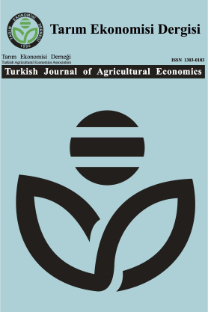Gıda ve İçecek Tüketiminde Yeni Trendlerin Değerlendirilmesi
Gıda ve içecek
sektörü yoğun rekabete sahip dinamik bir sektördür. Çeşitli faktörlerin
etkisiyle zaman içerisinde gıda tüketim alışkanlıkları değişmiş ve ortaya çıkan
yeni trendler sektörü, gıda ve içecek tüketimini etkilemeye başlamıştır. Bu
çalışmanın amacı, gıda ve içecek tüketimindeki yeni trendleri ortaya koymak ve bu
trendlerin Türkiye gıda ve içecek sektöründeki kullanım şekillerini
belirlemektir. Çalışmanın sonucunda
sağlık, kolaylık, keyif, sürdürülebilirlik, otantiklik yaklaşımları, gıda ve
içecek tüketiminde önemli yere sahip olan ve gelecekte de hem tüketimi hem de
sektörü etkileyecek olan beş ana trend olarak belirlenmiştir.
An Evaluation of New Trends in the Food and Beverage Consumption
Food and beverage sector is a dynamic sector with an intense competition. With the influence of various factors, food consumption habits have changed over time and emerging new trends started to affect the sector, food and beverage consumption.The aim of this study is to reveal new trends in food and beverage consumption and to determine the usage patterns of these trends in Turkey's food and beverage sector. As a result of the study; health, convenience, pleasure, sustainability, authenticity approaches have been identified as the five main trends that have an important place in the food and beverage consumption and also will affect both consumption and the sector in the future.
Keywords:
Food, beverage, consumption, trend, health,
___
- Ahlgren, M. K., Gustafsson, I. B., Hall, G. 2005. The impact of the meal situation on the consumption of ready meals, International Journal of Consumer Studies, 29(6): 485-492.
- Arıkan, A. 2012. Ambalaj Yönetiminde Kaynak Azaltma, Önleme ve Sürdürülebilirlik Ambalaj Atığı Yönetiminde Önleme, Mevzuatlar Kapsamında Ambalaj Atıkları Yönetimi Semineri, 9 Ekim, İstanbul.
- Birkenhead, K. L., Slater, G. 2015. A review of factors influencing athletes’ food choices, Sports Medicine, 45(11): 1511-1522. Buckley, M., Cowan, C., McCarthy, M., O'Sullivan, C. 2005. The convenience consumer and food-related lifestyles in Great Britain, Journal of Food Products Marketing, 11(3): 3-25.
- Casini, L., Contini, C., Romano, C., Scozzafava, G. 2015. Trends in food consumptions: what is happening to generation X, British Food Journal, 117(2): 705-718. Garcia, G., Sunil, T. S., Hinojosa, P. 2012. The fast food and obesity link: consumption patterns and severity of obesity, Obesity surgery, 22(5): 810-818.
- Grunert, G.K, Tudoran, A.A., Chrysochou, P., Migkou, T., 2012. Trends In New Products Launches In The Food Industry, MAPP Centre for Research on Customer Relations in the Food Sector, Aarhus University.
- Henkes, D., 2017. Food Industry Forecast: Key Trends Through 2020, http://www.emerson.com/resource/blob/151204/2750d07cf85feaf08f814e85799fcacc/food-industry-forecast-henkes-090315-data.pdf (Erişim Tarihi: 5 Şubat 2017).
- International Markets Bureau, 2010, Consumer Trend Report Convenience, Market Analysis Report, June 2010.
- International Markets Bureau, 2011, Global Consumer Trends Sensory Food Experinces, Market Analysis Report, September 2011.
- İSO 500, 2018. Türkiye’nin 500 Büyük Sanayi Kuruluşu, http://www.iso500.org.tr/ (Erişim Tarihi: 18 Şubat 2018).
- Jabs, J., Devine, C. M. 2006. Time scarcity and food choices: an overview, Appetite, 47(2): 196-204.
- Jacques, C., 2017. New Food Business Models Capture 5% to 25% Premium for Added Convenience, http://www.luxresearchinc.com/news-and-events/press-releases/read/new-food-business-models-capture-5-25-premium-added-convenience (Erişim Tarihi: 12 Şubat 2017).
- Kalkınma Bakanlığı, 2014. Onuncu Kalkınma Planı, Gıda Ürünleri ve Güvenilirliği Özel İhtisas Komisyonu Raporu, Ankara.
- Keskin, B., Güneş, E., 2017. Tarıma Dayalı Sanayiilerde Sürdürülebilirlik Yaklaşımları, III. Ibaness Kongreler Serisi, 4-5 Mart 2017, Edirne, s. 170-182, http://www.ibaness.org/conferences/edirne/IBANESS_Edirne_Proceedings_01_03_2017.pdf (Erişim Tarihi: 6 Mart 2017).
- Keskin, B., Demirbaş, N., Güneş, E., 2018. “Sustainable development of agri-food sector in Turkey”, p.47-57. Sustainable development and competitiveness of regions. Collective monograph. Editor: Prof. Ognyana Stoichkova, Ph.D. Academic publishing house “Talent”, University of agribusiness and rural development, Plovdiv, 2018, Volume 1, 278 p. First edition, ISBN 978-619-203-230-2 (e-book).
- Koç, G. 2015. Tarım ve Gıdada Sürdürülebilir Tedarik Zinciri. http://www.academia.edu/10279782/TARIMDA_ve_GIDADA_SÜRDÜRÜLEBİLİR_TEDARİK_ZİNCİRİ_TÜRKİYE_İNCELEMESİ (Erişim Tarihi: 12 Mayıs 2015).
- Kodaz, D. 2013. Fonksiyonel Gıdalar, https://www.foodelphi.com/fonksiyonel-gidalar-dursun-kodaz/ (Erişim Tarihi: 1 Şubat 2017).
- Kükrer, Ö., 2011. Üniversite Öğrencilerinde Hedonik Tüketimin Cinsiyete Göre Farklılaşması, İletişim Araştırmaları Dergisi, Cilt 1, 78-87.
- Lockie, S., Lyons, K., Lawrence, G., Mummery, K. 2002. Eating ‘green’: motivations behind organic food consumption in Australia, Sociologia ruralis, 42(1): 23-40.
- Makatouni, A. 2002. What motivates consumers to buy organic food in the UK? Results from a qualitative study, British Food Journal, 104(3/4/5): 345-352.
- Martínez Michel, L., Anders, S., Wismer, W. V. 2011. Consumer Preferences and willingness to pay for value‐added chicken product attributes, Journal of food science, 76(8): 469-477.
- Mehmeti, G., Xhoxhi, O. 2014. Future Food Trends, Annals. Food Science and Technology, 15(2): 392-400.
- Nielsen, 2015, We Are What We Eat Healthy Eating Trends Around The World, https://www.nielsen.com/content/dam/nielsenglobal/eu/nielseninsights/pdfs/Nielsen%20Global%20Health%20and%20Wellness%20Report%20-%20January%202015.pdf (Erişim Tarihi: 10 Şubat 2017).
- Paul, J., & Rana, J. 2012. Consumer behavior and purchase intention for organic food, Journal of consumer Marketing, 29(6): 412-422.
- Pereira, M. A., Kartashov, A. I., Ebbeling, C. B., Van Horn, L., Slattery, M. L., Jacobs, D. R., Ludwig, D. S. 2005. Fast-food habits, weight gain, and insulin resistance (the CARDIA study): 15-year prospective analysis, The lancet, 365(9453): 36-42.
- PricewaterhouseCoopers, 2012. 2041’de Türkiye Geleceğe Bakış, http://www.pwc.com.tr/tr/publications/arastirmalar/pdf/2041deturkiye.pdf (Erişim Tarihi: 3 Şubat 2017). Scholliers, P. 2015. Convenience foods. What, why, and when. Appetite, 94, 2-6.
- Temürcü, C. 2013. Gerçek Gıda Ucuz Olabilir Mi. http://yesilgazete.org/blog/2013/07/10/gercek-gida-ucuz-olabilir-mi-ceyhan-temurcu/ (Erişim Tarihi: 11 Mayıs 2015).
- Tudoran, A. A., Fischer, A. R. H., Van Trijp, H. C. M., Grunert, K., Krystallis, A., Esbjerg, L. 2012. Overview of consumer trends in food industry, MAPP Centre, Aaarhus University.
- TGDF, 2011. Sürdürülebilir Çevre, Comart Kurumsal İletişim Hizmetleri, Deniz Matbaacılık, Ankara.
- ISSN: 1303-0183
- Yayın Aralığı: Yılda 2 Sayı
- Başlangıç: 1992
- Yayıncı: Tarım Ekonomisi Dergisi
Sayıdaki Diğer Makaleler
Plastik Serada SivrBiber Üretiminin Teknik Etkinliği: Mersin İli Örneği, Türkiye
Zeki BAYRAMOĞLU, Orhan GÜNDÜZ, Zuhal KARAKAYACI, Yusuf ÇELİK
Türkiye'de Coğrafi İşaretli Gıda Ürünlerinin Gurme Turizmi Açısından Önemi
Bilal BİLGE, Nevin DEMİRBAŞ, Metin ARTUKOĞLU
İzmr'n Kentsel Kesmnde Sera Sebzeler Tüketmnn Analz
Gizem ÖZÇINGIRAK, Sait ENGİNDENİZ
Gıda ve İçecek Tüketiminde Yeni Trendlerin Değerlendirilmesi
Tarım İşletmelerinde Sürdürülebilirliğin Ölçülmesi: Aydın İli Örneği
Türkiye'de Gelirin Gıda Tüketimi Üzerine Etkisi
Alper DEMİRDÖĞEN, Emine OLHAN, Gökhan AYKAÇ
Emre TORGUT, Serdar ANNAYEV, Mürşide Çağla ÖRMECİ KART, Berna TÜRKEKUL
Tarım İşletmelerinde Sürdürülebilirliğin Ölçülmesi, Aydın İli Örneği
